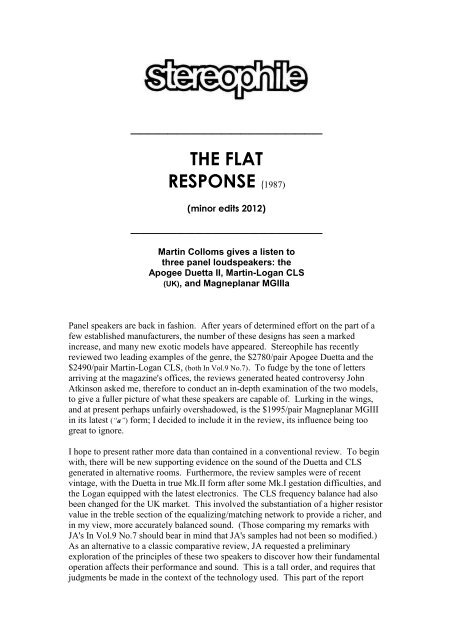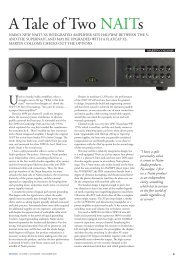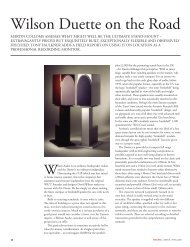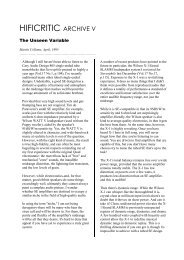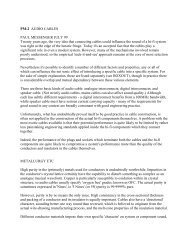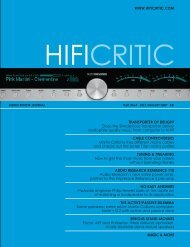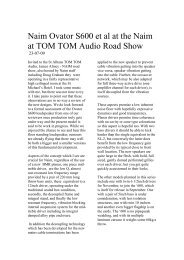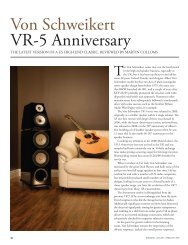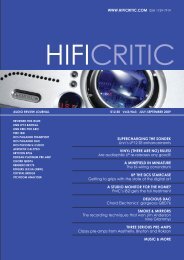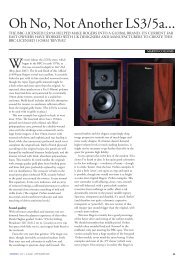Create successful ePaper yourself
Turn your PDF publications into a flip-book with our unique Google optimized e-Paper software.
_____________________<br />
THE FLAT<br />
RESPONSE (1987)<br />
(minor edits 2012)<br />
_____________________<br />
Martin Colloms gives a listen to<br />
three panel loudspeakers: <strong>the</strong><br />
Apogee Duetta II, Martin-Logan CLS<br />
(UK), and Magneplanar MGIIIa<br />
Panel speakers are back in fashion. After years of determined effort on <strong>the</strong> part of a<br />
few established manufacturers, <strong>the</strong> number of <strong>the</strong>se designs has seen a marked<br />
increase, and many new exotic models have appeared. Stereophile has recently<br />
reviewed two leading examples of <strong>the</strong> genre, <strong>the</strong> $2780/pair Apogee Duetta and <strong>the</strong><br />
$2490/pair Martin-Logan CLS, (both In Vol.9 No.7). To fudge by <strong>the</strong> tone of letters<br />
arriving at <strong>the</strong> magazine's offices, <strong>the</strong> reviews generated heated controversy John<br />
Atkinson asked me, <strong>the</strong>refore to conduct an in-depth examination of <strong>the</strong> two models,<br />
to give a fuller picture of what <strong>the</strong>se speakers are capable of. Lurking in <strong>the</strong> wings,<br />
and at present perhaps unfairly overshadowed, is <strong>the</strong> $1995/pair Magneplanar MGIII<br />
in its latest (“a”) form; I decided to include it in <strong>the</strong> review, its influence being too<br />
great to ignore.<br />
I hope to present ra<strong>the</strong>r more data than contained in a conventional review. To begin<br />
with, <strong>the</strong>re will be new supporting evidence on <strong>the</strong> sound of <strong>the</strong> Duetta and CLS<br />
generated in alternative rooms. Fur<strong>the</strong>rmore, <strong>the</strong> review samples were of recent<br />
vintage, with <strong>the</strong> Duetta in true Mk.II form after some Mk.I gestation difficulties, and<br />
<strong>the</strong> Logan equipped with <strong>the</strong> latest electronics. The CLS frequency balance had also<br />
been changed for <strong>the</strong> UK market. This involved <strong>the</strong> substantiation of a higher resistor<br />
value in <strong>the</strong> treble section of <strong>the</strong> equalizing/matching network to provide a richer, and<br />
in my view, more accurately balanced sound. (Those <strong>com</strong>paring my remarks with<br />
JA's In Vol.9 No.7 should bear in mind that JA's samples had not been so modified.)<br />
As an alternative to a classic <strong>com</strong>parative review, JA requested a preliminary<br />
exploration of <strong>the</strong> principles of <strong>the</strong>se two speakers to discover how <strong>the</strong>ir fundamental<br />
operation affects <strong>the</strong>ir performance and sound. This is a tall order, and requires that<br />
judgments be made in <strong>the</strong> context of <strong>the</strong> technology used. This part of <strong>the</strong> report
should not be taken too literally in terms of <strong>the</strong> analysis of sound quality; if<br />
audiophiles were fully briefed on <strong>the</strong> limitations of most designs, many would refuse<br />
to buy a speaker at all. What does matter is <strong>the</strong> subjective judgment of <strong>the</strong> final<br />
result, governed by price and expectation. As <strong>the</strong> report developed, <strong>the</strong> Duettas and<br />
<strong>the</strong> Logans begin to position <strong>the</strong>mselves at extremes of technology and specific<br />
performance, while <strong>the</strong> Magneplanar emerged as <strong>the</strong> classic, balanced, middle-of-<strong>the</strong>road<br />
contender.<br />
Design Compromises<br />
Although radically different in appearance, <strong>the</strong> Duetta and <strong>the</strong> CLS are both mediumsized,<br />
floor-standing, open-panel speakers. The Duetta is a two-way system, with a<br />
moderately sized, broad-band ribbon tweeter working through <strong>the</strong> upper mid and<br />
treble ranges. It is related to <strong>the</strong> three-way Scintilla, which uses 2 <strong>com</strong>posite<br />
multiple-ribbon systems for <strong>the</strong> mid and treble ranges.<br />
The number of “ways” is crucial to a design, since no single transducer can properly<br />
en<strong>com</strong>pass <strong>the</strong> breadth of <strong>the</strong> audible frequency range. From <strong>the</strong> design viewpoint,<br />
<strong>the</strong> more ways - i.e., <strong>the</strong> greater <strong>the</strong> number of divisions of <strong>the</strong> frequency range <strong>the</strong><br />
more freedom <strong>the</strong>re is for <strong>the</strong> engineer to trim and balance <strong>the</strong> frequency <strong>response</strong> to<br />
provide a natural sound. Conversely, with a low number of “ways” <strong>the</strong> designer has<br />
to fight for continuity and an even power over <strong>the</strong> range, not always with <strong>com</strong>plete<br />
success. Increasing <strong>the</strong> “ways” however, makes it more difficult to design a wellintegrated<br />
full-range system this difficulty greater than <strong>the</strong> increase in <strong>com</strong>plexity.<br />
Apogee Duetta Details<br />
Apogee has pioneered <strong>the</strong> use of modern “ribbon” technology, and in <strong>the</strong> case of <strong>the</strong><br />
Duetta, this description is certainly true for <strong>the</strong> HF unit. Here, a tall, pleated<br />
aluminium foil/Kapton ribbon with three series connected conducting paths is<br />
suspended between <strong>the</strong> poles of a powerful, linear, open magnet. The radiation is bidirectional<br />
and dipolar, <strong>the</strong> energy behind being out of phase by 180 degrees with that<br />
for <strong>the</strong> front. Unless placed very close to a back wall, this will not result in specific<br />
cancellation save at 90 degrees to <strong>the</strong> speaker, since by <strong>the</strong> time wall reflected rear<br />
waves have <strong>com</strong>bined with <strong>the</strong> direct radiation; <strong>the</strong>ir phase is randomly<br />
indeterminate. Suppose <strong>the</strong> panel is typically placed at five feet from <strong>the</strong> back wall,<br />
and <strong>the</strong> listener is 15 feet from <strong>the</strong> speaker. At <strong>the</strong> low frequency end of <strong>the</strong> range<br />
handled by <strong>the</strong> tweeter ribbon, say 1kHz, <strong>the</strong> listener is 15 wavelengths away from <strong>the</strong><br />
front-panel sound, and 25 wavelengths from <strong>the</strong> reflected sound to <strong>the</strong> rear. Given<br />
normal room reflections, specific cancellations will be diffused and of small<br />
significance; with reducing frequency, however, this factor will assume increasing<br />
importance.<br />
The lower frequency range of <strong>the</strong> Duetta is handled by a stretched film diaphragm,<br />
tensioned and supported over its whole boundary perimeter, also a dipole, and<br />
quaintly referred to by Apogee as a “ribbon”. Its motion is akin to a drum skin, as is<br />
that of <strong>the</strong> Magneplanars and <strong>the</strong> vast majority of electrostatics. This is quite distinct<br />
from <strong>the</strong> piston-like, push-pull, action of a freely suspended ribbon whose<br />
fundamental to-and-fro resonance may be so low as to occur below <strong>the</strong> audible range.<br />
At present, it is inconceivable that a loudspeaker could be made to operate full range
in a true ribbon form. The magnet system would be so huge that no-one would be<br />
able to move it. It is also likely that such a design would overload prematurely at<br />
infrasonic frequencies.<br />
Apogee has over<strong>com</strong>e, in a number of ways, many of <strong>the</strong> fundamental resonance<br />
problems of such a stretched diaphragm. The moving element of <strong>the</strong>ir woofer is a<br />
laminated <strong>com</strong>bination of aluminium foil and Kapton plastic tape with good selfdamping<br />
properties. The element is generally pleated in <strong>the</strong> horizontal direction to<br />
increase its resistance to bending in that plane, while <strong>the</strong> shape is semi-trapezoidal to<br />
maximize its geometric asymmetry and thus control <strong>the</strong> natural upper frequncy<br />
resonant modes. Finally, <strong>the</strong> upper and lower sections of <strong>the</strong> diaphragm are<br />
differentially tensioned by adjustable clamps to provide a broad, double-tuned lowfrequency<br />
resonance, ra<strong>the</strong>r than one of a higher Q.<br />
Several factors control <strong>the</strong> frequency <strong>response</strong> of an open panel. At low frequencies,<br />
<strong>the</strong> bass rolls off at 6dB/octave from quite a high frequency, here about 150Hz and is<br />
generally augmented by some intended diaphragm resonance(s). After passing<br />
through a fairly level region, <strong>the</strong> output begins to fall naturally with increasingly<br />
frequency and <strong>the</strong> drive signal must be crossed over to <strong>the</strong> next driver before this<br />
happens -in <strong>the</strong> case of <strong>the</strong> Duetta, around 500Hz. For <strong>the</strong> mid-treble ribbon element,<br />
<strong>the</strong> low-frequency roll-off acctually begins at over 1kHz, and <strong>the</strong> crossover overlap is<br />
deliberately broad to help fill in <strong>the</strong> energy. Once again, given some consideration of<br />
<strong>the</strong> acoustics of <strong>the</strong> vertical slot in which <strong>the</strong> tall ribbon tweeter operates, and <strong>the</strong> mild<br />
canting of <strong>the</strong> element to improve <strong>the</strong> vertical directionality, <strong>the</strong> treble ribbon's output<br />
does decline at <strong>the</strong> top of its range. In <strong>the</strong> case of <strong>the</strong> Duetta, this inflection is at<br />
frequencies above 12kHz. The Scintilla's more extended top-end <strong>response</strong> is assured<br />
by its vertically arranged line of four half-inch wide ribbons of wider directivity,<br />
which augment <strong>the</strong> output from <strong>the</strong> mid-treble ribbon.<br />
The Duetta's treble ribbon is a wide-range transducer, covering a range from some<br />
500Hz to 22kHz, and is of exceptional sound quality. Advantages of this large ribbon<br />
include a virtual absence of resonance or coloration, with great acoustic transparency<br />
- no physical obstruction before or behind <strong>the</strong> driver element, plus direct coupling of<br />
<strong>the</strong> applied electro-mechanical force to <strong>the</strong> air. The virtual line source, but narrow<br />
form achieves good horizontal directivity. However, owing to <strong>the</strong> wide magnet gap,<br />
necessary to ac<strong>com</strong>modate <strong>the</strong> freely moving conductor, <strong>the</strong> tweeter does not offer<br />
much sensitivity. Running <strong>the</strong> three conductor elements of <strong>the</strong> ribbon in series brings<br />
<strong>the</strong> load impedance to 4 ohms, but <strong>the</strong> sensitivity remains very low, in speaker terms,<br />
at typically 78dB/W (this is an 8-ohm watt), which is some 10dB below <strong>the</strong> average.<br />
There are obvious penalties to pay for this low sensitivity in terms of required<br />
amplifier power.<br />
The Duetta's low-frequency driver is necessarily subject to some intrinsic resonance<br />
modes (as does <strong>the</strong> Magneplanar) and, in addition, suffers from some acoustic<br />
obstruction due to <strong>the</strong> perforated steel-plate baffle back plate used to support <strong>the</strong><br />
massive array of single sided planar magnets. These provide <strong>the</strong> distributed magnetic<br />
field associated with <strong>the</strong> zigzag current flow of <strong>the</strong> diaphragm conductor pattern. The<br />
acoustic “window area” of <strong>the</strong> bass section is not very high, though if this were<br />
increased, rigidity would suffer. The bass driver, having a one-sided magnetic field,<br />
is driven in single-ended ra<strong>the</strong>r than <strong>the</strong> preferred push-pull mode. In <strong>the</strong>ory, this
would confer higher distortion levels, but in practice, <strong>the</strong> distortion from such a large<br />
radiating area is quite negligible, even at realistically high sound-pressure levels as<br />
<strong>the</strong> excursion remains small.<br />
Due to <strong>the</strong>ir large area, <strong>the</strong> Duetta diaphragms radiate heat well, providing a high<br />
power handling which is necessary in view of <strong>the</strong> low sensitivity. A particular feature<br />
of <strong>the</strong> Apogee drive system is its very high inherent linearity, resulting in a freedom<br />
from <strong>the</strong> <strong>com</strong>pression effects apparent in many moving-coil systems, as well as in<br />
some electrostatics when <strong>the</strong> peak handling limits are exceeded.<br />
Martin-Logan CLS<br />
Turning to <strong>the</strong> Martin-Logan CLS full range electrostatic, this open-panel speaker<br />
must also suffer <strong>the</strong> low-frequency roll-off limitation of a finite sized baffle or in this<br />
case open radiator, and copes with this by means of a designed resonance at 50Hz.<br />
(Quad similarly resorts to a medium Q low frequency resonance). The electrostatic<br />
principle is attractive in many respects, not least because it allows <strong>the</strong> use of an<br />
extremely light diaphragm - so light, in fact, that its vibratory contact with <strong>the</strong> air<br />
molecules may be used as a palliative, controlling, damping mechanism. Light<br />
diaphragms can thus move quickly, promising good high-frequency <strong>response</strong>, while<br />
<strong>the</strong>ir low inertia assures a low level of stored energy, promising an accurate transient<br />
<strong>response</strong>.<br />
In principle, <strong>the</strong> electrostatic driver is very efficient in its conversion of moving<br />
electric charge into acoustic power. Problems arise, however, in interfacing <strong>the</strong><br />
necessarily large electrostatic and low acoustical impedance element to <strong>the</strong> room<br />
acoustic, as well as to <strong>the</strong> power amplifier. The science of electrostatics is <strong>the</strong> science<br />
of high voltages, with <strong>the</strong> polarizing field established by as much as 7kV applied to<br />
<strong>the</strong> inner-shielded diaphragm. Ideally, <strong>the</strong> fixed-mesh electrodes on ei<strong>the</strong>r side of <strong>the</strong><br />
diaphragm need to be driven in push-pull at upward of 500V, and require isolation<br />
from <strong>the</strong> user. (In <strong>the</strong> case of <strong>the</strong> Quad, <strong>the</strong> electrodes are protected behind grounded<br />
mesh screens.)<br />
A thick, tough, black plastic insulating coating is applied to <strong>the</strong> strong CLS steel<br />
plate electrodes; <strong>the</strong>se simultaneously form <strong>the</strong> external grilles of <strong>the</strong> speaker. Highratio<br />
step-up transformers are used to couple <strong>the</strong> amplifier to <strong>the</strong> diaprhgm, while <strong>the</strong><br />
reactive input characteristic is not one that allows for optimum power transfer. An<br />
electrostatic offers an input characteristic that is predominantly capacitive, hardly an<br />
ideal load. By <strong>the</strong> time <strong>the</strong>se considerations have been taken into account, as well as<br />
<strong>the</strong> need to improve <strong>the</strong> narrowing directivity with frequency of a single large<br />
diaphragm, <strong>the</strong> much-vaunted efficiency has been whittled away. Never<strong>the</strong>less, most<br />
electrostatics have a basic sensitivity of around 85dB/W (8 ohms), which is ra<strong>the</strong>r<br />
better than that achieved by present large ribbon systems. Martin Logan have some<br />
interesting design features which are used to gain a more favourable directivity.<br />
The CLS diaphragm is unusual, for although it is only 0.004" thick, and consequently<br />
very light (<strong>the</strong> whole moving system is reckoned to weigh <strong>the</strong> same as one cubic inch<br />
or 16.4ml of air), it is formed from a pretty rigid plastic and is almost self-supporting.<br />
No surface damping is used in <strong>the</strong> diaphragm; its stretched “skin” and “plate”<br />
vibration modes are partially controlled in <strong>the</strong> first instance at <strong>the</strong> boundaries, where a
lossy foam-plastic mounting is used, and by <strong>the</strong> acoustic impedance of <strong>the</strong> air load<br />
imposed on <strong>the</strong> diaphragm. ( but also by <strong>the</strong> positioning of <strong>the</strong> fur<strong>the</strong>r foam support<br />
strips) .<br />
For <strong>com</strong>parison, <strong>the</strong> Quad ESL-63 uses a ra<strong>the</strong>r thinner 0.00137" diaphragm, (with<br />
0.001" plastic film for <strong>the</strong> dust-cover membranes.) The CLS uses a density of Mylar<br />
polymer similar to Quad, here giving a total mass of around 20 milligrams. (By<br />
<strong>com</strong>parison <strong>the</strong> ESL-63 is even more extraordinary, its diaphragm weighing just<br />
0.003gm, or 3 milligrams, not too far removed from <strong>the</strong> tip mass of a pickup<br />
cartridge!) Ano<strong>the</strong>r interesting <strong>com</strong>parison is with a typical wide-band moving-coil<br />
dome tweeter, where <strong>the</strong> moving mass is typically around 200mg. Quads enjoy<br />
higher levels of air-damping than Martin-Logans and, in addition, use an interlayer of<br />
<strong>the</strong> sheerest gauze to provide some resistive mechanical contact to <strong>the</strong> diaphragm<br />
surface, damping free modes.<br />
From its appearance it is obvious that <strong>the</strong> CLS diaphragm is broken up into discrete<br />
radiating areas by damping strips. It is possible to physically deflect <strong>the</strong>se separate<br />
“cells” by blowing on <strong>the</strong>m. As when air is blown over <strong>the</strong> necks of differently sized<br />
bottles, each one has its own distinct “sound”. By this differential multi-cell means,<br />
dominant resonances are moderated and dispersed by dimensioning each rectangular<br />
cell differently.<br />
The vertical side <strong>com</strong>partments of <strong>the</strong> CLS diaphragm are of fairly high Q, and are<br />
tuned to 50Hz. Above resonance, this level falls at 2 natural rate of 6dB/octave,<br />
partly <strong>com</strong>pensating for <strong>the</strong> naturally rising 6dB/octave <strong>response</strong> of <strong>the</strong> panel as a<br />
whole. Beyond this frequency, range, <strong>the</strong> double section, frequency -<strong>com</strong>pensated,<br />
step-up transformer applies a fur<strong>the</strong>r reduction in mid/treble level. Finally, <strong>the</strong><br />
distribution of <strong>the</strong> cells and <strong>the</strong> horizontal arc of <strong>the</strong> curvilinear diaphragm <strong>com</strong>plete<br />
<strong>the</strong> frequency balancing while increasing <strong>the</strong> horizontal coverage.<br />
A full-range planar diaphragm like <strong>the</strong> CLS be<strong>com</strong>es increasingly directional as <strong>the</strong><br />
wavelength of sound approaches <strong>the</strong> size of <strong>the</strong> panel. In <strong>the</strong> Magneplanars and<br />
Apogees, this is solved by allocating <strong>the</strong> subsequent frequency range to narrower and<br />
narrower line-source elements. For <strong>the</strong> concentric multi cell Quad, <strong>the</strong> diameter is<br />
subdivided no less than eight times, providing a controlled reduction of element size<br />
with frequency, and thus maintaining a good radiation angle. Martin-Logan deals<br />
with <strong>the</strong> problem in a different way: <strong>the</strong> electrostatic panel is formed into a nearparabolic<br />
contour with a prime radiation approaching a vertical half-cylinder. With<br />
this broader-angled distribution, some of <strong>the</strong> natural rise in frequency <strong>response</strong> is also<br />
offset.<br />
If <strong>the</strong> diaphragms were sufficiently well damped, and dimensionally stable to operate<br />
without <strong>the</strong> subdividing cells, this geometry would approach <strong>the</strong> ideal. In practice, <strong>the</strong><br />
cells boundaries terminate <strong>the</strong> high frequencies in a non-uniform manner, resulting in<br />
an arrays of treble radiators ra<strong>the</strong>r than a uniform whole. Such an array is likely to<br />
result in an off-axis polar <strong>response</strong> with a <strong>com</strong>plex fine structure at high frequencies.<br />
This will generate some level of random amplitude and phasing irregularities when a
stereo pair is considered. In <strong>the</strong> far field <strong>the</strong>se can be expected to coalesce to some<br />
degree.<br />
O<strong>the</strong>r Considerations<br />
Electrostatics generally have a finite sound level limit, due to considerations of peak<br />
voltage and electrical flashover, or saturation limiting in <strong>the</strong> cores of <strong>the</strong> step-up<br />
transformer. O<strong>the</strong>r problems include aging in <strong>the</strong> diaphragm, tensioning, and dust<br />
build-up due to electrostatic attraction. The Quad ESL-63 is dust-proofed, but <strong>the</strong><br />
Logan has no such protection, and I would suspect that its use in a dusty environment<br />
could be inappropriate. Conversely it is sufficiently robust to allow vacuuming!<br />
The Apogee has a physical weakness in that its diaphragms are relatively susceptible<br />
to damage; even a light finger touch will mar <strong>the</strong> fragile diaphragm surface and <strong>the</strong>re<br />
are no grilles.<br />
Magneplanars<br />
The well-established Magneplanar MGIIIa, based on a proprietary planar stretched<br />
film drive unit in which a wire-conductor array is bonded to <strong>the</strong> diaphragm, is<br />
probably <strong>the</strong> most durable of <strong>the</strong> three designs under test. The exposed bass and mid<br />
diaphragms are at <strong>the</strong> rear, behind <strong>the</strong> magnet array; <strong>the</strong>y are also sufficiently resilient<br />
to resist minor impacts. The true ribbon tweeter is also well guarded. The fact that<br />
<strong>the</strong> MGIIIa is a three-way design has given its designer more freedom to balance its<br />
frequency, <strong>response</strong>; it is arguably more successful in this particular respect than <strong>the</strong><br />
two o<strong>the</strong>r models. The ribbon is pure aluminium, just 0.5inch wide with very good<br />
horizontal directivity and an extended high frequency reponse.<br />
O<strong>the</strong>r advantages of <strong>the</strong> MGIIIa include a truly extended, wide-directivity high range,<br />
plus a respectable 86dB/W sensitivity and well-damped film diaphragms, achieved<br />
via a lossy coating and <strong>the</strong> use of a special adhesive for <strong>the</strong> wire conductor bonding.<br />
Acoustically speaking, <strong>the</strong> bass and mid sections are not as transparent and<br />
unobstructed as <strong>the</strong> Logan or <strong>the</strong> mid-treble section of <strong>the</strong> Duetta.<br />
Where <strong>the</strong> Apogee diaphragm are trapezoidal to help control <strong>the</strong> natural drum modes<br />
<strong>the</strong> rectangular examples of <strong>the</strong> Magneplanar have a set of judiciously placed modal<br />
clamps to help damp <strong>the</strong> more noticeable modes, which o<strong>the</strong>rwise colour <strong>the</strong> lower<br />
mid range.<br />
Sound Quality: Apogee Duetta II
I shall leave<br />
sound quality<br />
ra<strong>the</strong>r more<br />
<strong>the</strong> more effusively indulgent characteristics of<br />
to my American colleagues and present (I hope!) a<br />
academic and objective view.<br />
This speaker<br />
has improved considerably since my first<br />
acquaintance<br />
with <strong>the</strong> original samples some 15 months ago,<br />
which I<br />
declined to review. In my system, problems were<br />
experienced<br />
with tonal imbalance, midrange glare, and a lack<br />
of precision in<br />
<strong>the</strong> high treble, though o<strong>the</strong>r critics seem to have<br />
enjoyed greater success with its sound. With <strong>the</strong> Mk.II, I found a greatly improved<br />
uniformity of frequency <strong>response</strong>, and a high-treble problem was avoided. The<br />
speaker was easy and relaxing to live with, and had great virtues. However, <strong>the</strong>re was<br />
also what I feel to be a considerable flaw: <strong>the</strong> Duetta was demonstrably and<br />
unarguably rich in balance, and sounded dim when set against my established<br />
references, all of which have been directly <strong>com</strong>pared with live sound sources under<br />
controlled conditions. If <strong>the</strong> Duetta is <strong>the</strong> only speaker you use, or perhaps <strong>the</strong> only<br />
speaker used that day, and you only play your brightest-sounding records, <strong>the</strong>n you<br />
might be<strong>com</strong>e accustomed to its tonal imbalance. In my 80m³ room, <strong>the</strong> bass was<br />
almost overpowering in level, while <strong>the</strong> balance sounded as if down-tilted with<br />
increasing frequency all <strong>the</strong> way from 50Hz to 10kHz. (Imagine a Quad 34 or 44 tilt control<br />
rotated fully to slope downwards.) I felt a strong urge to beg, steal, or borrow <strong>the</strong> nearest<br />
Cello Palette and attempt some moderation of this speaker's slow, ponderous<br />
character.<br />
(with hindsight that rich balance was engineered partly to account for low frequency<br />
losses in <strong>the</strong> larger open plan US living spaces)<br />
In addition, while <strong>the</strong> problem I had perceived above 12kHz from <strong>the</strong> Mk.I had gone,<br />
so, it appeared, had <strong>the</strong> extreme treble itself. The treble sounded filtered, with little<br />
air or sparkle in <strong>the</strong> final audio octave. The end result was still very sweet, but lacked<br />
a sufficiently “open” quality. Perhaps surprisingly, however, <strong>the</strong> Duetta sounded best<br />
with <strong>the</strong> treble switch up (i.e., dimmer). With <strong>the</strong> switch set down, <strong>the</strong> treble was lifted<br />
slightly at <strong>the</strong> expense of a mild return of upper-mid “glare,” something I can do<br />
without. I also indulged in some strictly illegal fiddling: I tried placing 1.5-ohm<br />
resistors (25 watt wirewound) in series with <strong>the</strong> woofer panels, which also helped <strong>the</strong><br />
tonal balance somewhat.<br />
The Duettas are amazingly insensitive; for example, Audio Research M100s (on <strong>the</strong>ir 4-<br />
ohm taps) sounded wonderful at low levels, but failed to stir <strong>the</strong> Duetta into life at high<br />
levels. Substitution of Krell KMA-100s (lovely amplifiers <strong>the</strong>se, despite <strong>the</strong>ir being solidstate)<br />
essentially maintained <strong>the</strong> standard of reproduction but added some 6dB of level,<br />
bringing <strong>the</strong> Duettas to a satisfactory volume level.<br />
A quick lab check showed that <strong>the</strong> KMA-100 could churn out 200 watts into 8 ohms<br />
and 360W into 4, yet to obtain <strong>the</strong> full dynamic range I believe <strong>the</strong> Duetta capable of,<br />
I felt <strong>the</strong> need for a KMA-200 or <strong>the</strong> equivalent. In-room, this would establish<br />
maximum sound levels of typically 105dBA from a stereo pair. For reference, a KEF<br />
R107 fed a standard 100W (8 ohms) per channel will deliver 107dBA. An MGIIIa fed<br />
its power limit of 100W (8 ohms) would deliver a satisfactory 101dBA.
With its rich balance, <strong>the</strong> Duetta needed heavy driving to bring up <strong>the</strong> mid and treble<br />
ranges subjectively, whereupon <strong>the</strong> magic qualities of this fundamentally musical<br />
transducer were <strong>the</strong>n revealed. Most of <strong>the</strong> frequency range was of high purity with<br />
excellent transparency, and once you had be<strong>com</strong>e adapted to this speaker tonally, it<br />
rewarded you with an excellent focus, fine orchestral perspectives, and big sound<br />
stages. The usable treble range was dulled, but o<strong>the</strong>rwise of very fine quality leaving<br />
aside <strong>the</strong> question of balance, <strong>the</strong> bass was appearing powerful, clean, articulate, and<br />
extended, virtually to <strong>the</strong> subwoofer level. *<br />
* In larger rooms - 200m³ - <strong>the</strong> bass was proportionately reduced, and much better<br />
balanced.<br />
But most importantly, <strong>the</strong> midrange was very good indeed, and worthy of both <strong>the</strong><br />
brand name and <strong>the</strong> asking price.<br />
Coloration (in <strong>the</strong> resonance sense) was very low, <strong>the</strong> sound imbued with a great sense of<br />
ease. The Duettas were not immediately lively, in a dynamic sense, but did continue<br />
to impress with <strong>the</strong>ir high resolution of inner detail, as well as by <strong>the</strong>ir discrimination<br />
of subtle harmonic shadings.<br />
Sound Quality: Martin-Logan CLS<br />
An earlier CLS had sounded quite impressive-lively, brilliantly clear, and full of<br />
dynamics as well as considerable musical information. Ultimately, however, it had<br />
proved a trifle wearing in that its tonal balance was up-tilted - too bright - <strong>the</strong><br />
converse of <strong>the</strong> Duetta. The current review sample sported <strong>the</strong> latest-electronics<br />
<strong>com</strong>prising a factory-specified treble resistor selection, which has balanced it closer to<br />
tonal neutrality.
This CLS was better balanced than before, yet much of its impressively exciting<br />
“liveliness” was still apparent. My listening notes contain a very good first<br />
impression, which placed it in <strong>the</strong> true high end. The broad midrange was<br />
undoubtedly very fine, and sounded quite remarkable on plucked instruments, such as<br />
harp and acoustic guitar. As with <strong>the</strong> best panel speakers, <strong>the</strong> absence of <strong>the</strong> usual<br />
wooden-box colorations came as a wel<strong>com</strong>e relief. The mid was highly informative<br />
and immediate, with that now much-sought-after “direct-coupled” character.<br />
The speaker could play pretty loud with quite modest amplifiers, and showed a<br />
surprisingly healthy bass and bass-power handling. If I had stopped listening here,<br />
<strong>the</strong> CLS would have sailed through <strong>the</strong> subjective testing; however, as <strong>the</strong> listening<br />
period was extended, I became increasingly aware of certain adverse effects that<br />
ultimately moderated my early good opinions of this model.<br />
For example, I found <strong>the</strong> stereo imaging restless and aurally un<strong>com</strong>fortable. To put it<br />
bluntly, <strong>the</strong> upper range, beyond 5kHz say, was “phasey”. *<br />
(* JGH also noted this quality when he heard <strong>the</strong> CLS's in J. A.’s room. He refers to<br />
this as <strong>the</strong> “Venetian blind” effect. )<br />
By this i mean that small head-position movements or changes resulted in<br />
disconcerting shifts in apparent image position. Higher-frequency instruments were<br />
often presented in a forward, manner, which tended to detract from <strong>the</strong> impression of<br />
depth. Unless one sat perfectly still, head virtually clamped, with <strong>the</strong> two speakers<br />
perfectly and symmetrically aligned, <strong>the</strong> stereo focus was consistently imperfect,<br />
restless, in <strong>the</strong> upper registers. In addition, <strong>the</strong> upper treble possessed a distinct,<br />
though subdued, “edge” or “fizz” above 10kHz. Finally, <strong>the</strong> bass, at first impressive,<br />
began to resolve itself into a one-note emphasis or “hangover” located in <strong>the</strong> midbass,<br />
with little extension apparent below this point.<br />
Small musical forces, such as a string trio, replayed exquisitely, but with larger forces<br />
<strong>the</strong> CLS showed a tendency to lose this higher level of clarity. In addition, it could be<br />
made to clip on moderately high levels of solo piano.
(JA mentioned this in his review; Martin-Logan reckons it due to core saturation In<br />
<strong>the</strong> drive transformer at <strong>the</strong> power handling limit).<br />
Careful <strong>com</strong>parisons on master-quality sources suggested that <strong>the</strong> treble range<br />
suffered from some fine structure unevenness ( roughness!) , while in terms of tonal<br />
balance it was felt to be somewhat midrange forward and showed some mild sourness<br />
on violin tone. Its overall performance brought to mind <strong>the</strong> inherent character of <strong>the</strong><br />
Decca cartridge: “direct-coupled” immediate sound, odd bass, and suspect treble, all<br />
allied to a marvellously “live” midrange.<br />
Sound Quality: Magneplanar MGIIIa<br />
This revised speaker was given <strong>the</strong> full review treatment by AHC in Vol.9 No.4, but<br />
for <strong>the</strong> sake of <strong>com</strong>pleteness, here are my brief notes on its sound. The treble was<br />
pleasantly pure, and very extended, directing a wide spread of “air” and “sparkle”<br />
into <strong>the</strong> room; a little too much so, in fact, for my tastes. The good treble added a<br />
sense of upper-range speed and delicacy that was somewhat lacking in both <strong>the</strong><br />
Duetta and CLS. The MGIIIa mid has been improved, now sounding faster and more<br />
open, and setting a genuinely good standard. The overall tonal balance was close to<br />
neutrality and did not draw much dissension from me. Certainly <strong>the</strong> mid was not as<br />
pure or transparent as ei<strong>the</strong>r <strong>the</strong> Duetta or CLS, but was no slouch for all that. The<br />
bass came midway between <strong>the</strong> two main contenders; at least it was present in better<br />
proportion, with pretty good extension, if not to Apogee standard. The MGIIIa was<br />
more tactile and articulate in <strong>the</strong> bass than <strong>the</strong> original MGIII, and in this respect, at<br />
least, has <strong>the</strong> CLS beat. Its bass was also of respectable uniformity.<br />
It proved easy to drive, and handled high input power levels gracefully, never<br />
sounding strained. Even when <strong>the</strong> bass was deliberately overloaded with over 100W<br />
at 50Hz, no bangs occurred-just a gentle “blurring” of <strong>the</strong> bass tone.
For <strong>the</strong> record, <strong>the</strong> Quad ESL-63, while not able to play rock bass to <strong>the</strong> same level of<br />
any of <strong>the</strong>se three speakers, was, in fact, <strong>the</strong> best of <strong>the</strong>m as regards tonal balance and<br />
low frequency uniformity It was also more consistently neutral to a wide range of<br />
sources.<br />
(PS: I also owned an MG111a for over a year)<br />
Technical Test Results: Apogee Duetta II<br />
Just how hard is <strong>the</strong> Duetta to drive? Contrary to rumour, it proved quite tolerable,<br />
no less than 5 ohms, almost purely resistive, on <strong>the</strong> “1” setting, and it would warrant<br />
an across-<strong>the</strong>-board specification of 6.4 ohms, which is an easy load in speaker terms.<br />
The amplifier problems arose, not from excessively low impedance as in <strong>the</strong> case of<br />
<strong>the</strong> 1-ohm Scintilla, but from its chronic insensitivity of about 80dB/W. The<br />
impedance graph (fig.1) reveals <strong>the</strong> crossover located at around 500Hz.<br />
FIG.1<br />
Measuring <strong>the</strong> sound output in 1/3-octave bands, <strong>the</strong> mid-tweeter <strong>response</strong>, shown on<br />
fig.2, is pretty healthy down to 400Hz.
FIG.2<br />
The vertical marker is placed at 12.5kHz, and graphically demonstrates <strong>the</strong> declining<br />
final octave, even when measured directly on-axis, with <strong>the</strong> mic on <strong>the</strong> “hottest”<br />
angle. Down 3dB at 12kHz, it was -10dB by <strong>the</strong> 20kHz 1/3-octave band. This graph<br />
also shows <strong>the</strong> output of <strong>the</strong> bass driver and its excessive level when interfaced with<br />
<strong>the</strong> tweeter, typically 6-8dB too high. (Note that this curve will en<strong>com</strong>pass some<br />
significant nearfield effects, particularly in <strong>the</strong> bass.)<br />
FIG.3<br />
Fig.3 is a <strong>com</strong>posite of <strong>the</strong> axial <strong>response</strong>, plus <strong>the</strong> output at 10 degrees above axis,<br />
and 30 degrees off <strong>the</strong> horizontal axis (dashed curve and toward <strong>the</strong> centre stage).<br />
This shows that <strong>the</strong> output off-axis is pretty well maintained in <strong>the</strong> desired manner.<br />
At 30 degrees to <strong>the</strong> horizontal, <strong>the</strong> 12kHz region picked up a little but with no<br />
significant improvement in <strong>response</strong> extension. On driver integration alone, <strong>the</strong>
Duetta can be rated well enough<br />
.<br />
Finally, we <strong>com</strong>e to <strong>the</strong> <strong>com</strong>puter-averaged <strong>response</strong> assessed in <strong>the</strong> listening space<br />
(fig.4), a summation of some 64 <strong>response</strong>s. In my 80m³ room, <strong>the</strong> 30Hz and 25Hz<br />
bands were clearly excessive in level, with <strong>the</strong> 30Hz rising 12dB above <strong>the</strong> <strong>com</strong>puted<br />
median. Note that <strong>the</strong> bass rise was part of a rising curve and not an isolated<br />
“boom”. From <strong>the</strong> <strong>response</strong> it is clear that <strong>the</strong> general energy trend is ra<strong>the</strong>r rich,<br />
with <strong>the</strong> midrange broadly weighted to a maximum in <strong>the</strong> 400Hz to 1kHz sector (<strong>the</strong><br />
marker is at 1kHz). Above 1kHz, <strong>the</strong> output declined some 5dB, though in a fairly<br />
controlled manner. The average output held up to 10kHz with a desirably smooth<br />
roll-off <strong>the</strong>reafter. The dotted curve shows <strong>the</strong> effect of <strong>the</strong> 1.5-ohm bass resistor - a<br />
mild improvement in balance.<br />
FIG.4<br />
Larger rooms would definitely improve <strong>the</strong> Duetta's bass-mid balance, though <strong>the</strong> low<br />
bass would remain over powerful down to 30Hz. For <strong>the</strong> benefit of those readers not<br />
familiar with <strong>the</strong>se room-averaged <strong>response</strong>s, I can assure you that it is possible to<br />
obtain a room curve using this method which runs within ± 3dB 25Hz to 200Hz,<br />
±2dB 200Hz to 8kHz, with a gentle roll-off <strong>the</strong>reafter. (This latter effect is due to <strong>the</strong> finite<br />
directivity of almost all <strong>com</strong>mercial tweeters at higher frequencies.) Blind listening tests have<br />
shown a consistently good correlation between perceived <strong>response</strong> and <strong>the</strong> room<br />
measurement.<br />
Technical Test Results: Martin-Logan CLS<br />
Looking at <strong>the</strong> amplifier load factor, <strong>the</strong> impedance curve (fig.5) is typically<br />
“electrostatic”. Low at low frequencies, and with no visible signs of <strong>the</strong> 50Hz<br />
diaphragm resonance, it climbs steeply to a harmless 33 ohms by 1kHz. Above this<br />
level, <strong>the</strong> load is almost purely capacitive, falling with frequency at 6dB/octave,<br />
reaching 2.5 ohms at 10kHz and finally bottoming out at a value of 1.6 ohms at<br />
20kHz largely capapcitance. Wide-band syn<strong>the</strong>sizers played at high level will not do
<strong>the</strong> amplifier-speaker <strong>com</strong>bination much good, while this load non-uniformity will<br />
cause more treble balance variations than usual with different cables and different<br />
amplifiers. In fact, one or two power amps may not be too stable with this load under<br />
heavy transient drive.<br />
FIG.5<br />
The CLS frame assembly seemed to show a mechanical resonance that was checked<br />
out acoustically (fig.6) and clearly placed at 160Hz. This resonance could be picked<br />
out on nearly all <strong>response</strong> curves taken.<br />
FIG.6<br />
The forward <strong>response</strong> set is shown in fig.7. Taking <strong>the</strong> solid axial line first, <strong>the</strong><br />
speaker output was high in <strong>the</strong> midrange, partly due to proximity. Above 1kHz, <strong>the</strong><br />
output was even and well-extended, suggesting a basically good tonal balance. No<br />
loss was seen by 20kHz. The low frequencies also deserve some <strong>com</strong>ment. As<br />
predicted by Gayle Sanders at Martin-Logan, <strong>the</strong> main resonance was precisely at
50Hz, and, in my view, showed excessive and isolated amplitude. The range above<br />
50Hz was deficient, while a steep roll-off held below 50Hz, <strong>the</strong> output already -8dB<br />
by 40Hz, and -18dB by 30Hz.<br />
FIG.7<br />
Given <strong>the</strong> smoothing advantage provided by 1/3-octave analysis, <strong>the</strong> off-axis<br />
<strong>response</strong>s of <strong>the</strong> CLS were remarkably good. It held a well-extended <strong>response</strong> over a<br />
wide range of angles, ±15 degrees vertical and up to 45 degrees horizontally. This is<br />
shown by <strong>the</strong> <strong>com</strong>mendable closeness of <strong>the</strong> off-axis <strong>response</strong> group.<br />
To explore <strong>the</strong> subjective <strong>com</strong>ment of “phasiness,” a narrow-band analysis was<br />
performed in <strong>the</strong> 500Hz-20.5kHz range for <strong>the</strong> axial <strong>response</strong>, and for a small 5-<br />
degree lateral angle change (fig.8).<br />
FIG.8
The results show that <strong>the</strong> CLS does have a peak at 15-16kHz (heard on audition), and<br />
that <strong>the</strong> two <strong>response</strong>s, although subjectively alike, do not correlate well. Inter<strong>response</strong><br />
differences of 3-5dB are frequent at high frequencies, which, of necessity,<br />
imply quite rapid phase shifts. These effects are typical of a multi-sourced, multilobed<br />
treble radiating system-<strong>the</strong> multiple cell configuration. The <strong>com</strong>puter-averaged<br />
room <strong>response</strong> (fig.9) provides <strong>the</strong> final stage of measurement analysis.<br />
FIG.9<br />
Here <strong>the</strong> 50Hz resonance can be clearly seen, while <strong>the</strong> energy loss above 60Hz is<br />
also apparent. The broad midrange is well balanced, while <strong>the</strong> upper treble is a little<br />
too well-extended at <strong>the</strong> highest extremity at 16kHz, suggesting an aural “edge” or<br />
corner. This is associated with <strong>the</strong> noted 16kHz axial prominence.<br />
Without claiming sonic superiority for <strong>the</strong> Quad 63, <strong>the</strong> <strong>response</strong> for this model under<br />
identical conditions (fig.10) makes for an interesting <strong>com</strong>parison. Quad has attained a<br />
<strong>com</strong>mendably uniform bass to 30Hz, with a broad sweep of uniform output held over<br />
<strong>the</strong> entire range, culminating in a naturally smooth room-energy roll-off in <strong>the</strong> highest<br />
frequencies. Yes, it can be done! ( <strong>the</strong> central mild prominence is at 1kHz).
FIG.10<br />
The CLS offered a below-average sensitivity of 84dB/W, with a power handling of<br />
100W per channel. Maximum room sound levels of typically 100dBA will be<br />
possible, though <strong>the</strong> speaker generally seemed to sound a mite louder than that thanks<br />
to <strong>the</strong> large source size projecting sound power fur<strong>the</strong>r into <strong>the</strong> room .<br />
Technical Test Results: Magneplanar MGIIIa<br />
I could not resist a sneak look at this speaker while it was “passing through <strong>the</strong> lab”.<br />
FIG.11<br />
Fig.11 is a “snapshot” of <strong>the</strong> forward axial <strong>response</strong>, showing some lift up to 16kHz.<br />
The mid-treble is linear and well integrated, while <strong>the</strong> bass is more or less level to<br />
40Hz, in good proportion with <strong>the</strong> rest.
The <strong>response</strong> in <strong>the</strong> listening room (fig.12) was remarkable at first sight, although <strong>the</strong><br />
upper treble was just too good to be true. In addition, <strong>the</strong> moderate prominence at 60-<br />
80Hz could ideally have been avoided. This curve confirms both <strong>the</strong> inherent<br />
neutrality of <strong>the</strong> IIIa, and its newfound extension to 25Hz in-room.<br />
Conclusion<br />
FIG.12<br />
I was fortunate in having access to all three speakers at on time during this three-way<br />
contest (though I am sure my wife did not agree!).<br />
Because <strong>the</strong> final purchase decision must include major considerations such as<br />
required loudness, room size, speaker placement, available amplification, and <strong>the</strong><br />
amplifier/speaker Interface, I find it hard to pick a winner. The kind of music played<br />
may also be important, while matters of personal taste on tonal balance are also<br />
crucial.<br />
Given a near-unlimited amplifier budget, my ultimate sympathies lie with <strong>the</strong> Duetta<br />
II. As a reviewer, however, I could not reasonably cope with it in its present state. It<br />
is simply too rich, tonally, too insensitive to use as a reviewing tool; If intended as <strong>the</strong><br />
basis for a music room ... well, that would be ano<strong>the</strong>r matter!<br />
If <strong>the</strong> diminished final octave does not matter too much, and if really high sound<br />
levels are not required, and if a large room is also available (quite a few “ifs”!), <strong>the</strong>n <strong>the</strong><br />
Duetta is <strong>the</strong> best choice. There is no doubt that its intrinsic quality was in <strong>the</strong> highest<br />
class, and implied no limit in terms of <strong>the</strong> matching amplifier quality; <strong>the</strong> ARC M100<br />
proved this, though it didn't achieve a sensibly loud volume level.<br />
I would ask Apogee to consider an approved modification for bypassing <strong>the</strong><br />
crossover. Dan D'Agostino could <strong>the</strong>n work up a nice equalized electronic crossover,<br />
working in conjunction with a pair of KSA-100s, to provide direct-coupled, bi-amped<br />
operation. I confidently predict that this <strong>com</strong>bination would provide one of <strong>the</strong> finest<br />
performances for <strong>the</strong> money presently available in <strong>the</strong> businesses. *
* Provisions have been made for <strong>the</strong> Duetta Series II to he driven via an active<br />
crossover. Owners should consult <strong>the</strong> manual for instructions.<br />
I also find <strong>the</strong> ML CLS has considerable merit, particularly for smaller orchestral<br />
forces, offering an essentially uncoloured, “fast” sound. Reservations remain,<br />
however, concerning <strong>the</strong> non-uniform impedance load, <strong>the</strong> peak midrange powerhandling<br />
for Its price and size class, that treble ‘phasiness’ and related fine structure<br />
irregularities, and, finally, <strong>the</strong> almost one-note 50Hz bass and little more.<br />
The CLS is an interesting speaker of remarkable appearance. Only a careful audition<br />
will properly inform a prospective customer, especially since broad areas of its<br />
frequency range do sound quite as transparent as it appears.<br />
Finally, we have <strong>the</strong> long established Magneplanar MGIIIa, which has not suffered<br />
too greatly in <strong>the</strong>se <strong>com</strong>parisons. Of eminently reasonable sensitivity, easy to drive,<br />
and possessing an essentially neutral tonal balance, it also has a notably wide<br />
frequency <strong>response</strong>, which survived well in my 20-foot long, 80m³ room. In no way<br />
can it be dismissed as “old technology”. Admittedly, <strong>the</strong> Maggie's mid range quality<br />
did not reach <strong>the</strong> neutral clarity peak of <strong>the</strong> Duetta or <strong>the</strong> CLS but it was none<strong>the</strong>less<br />
rated good. In <strong>the</strong> long term, its overall engineering integrity, its mature <strong>response</strong><br />
integration , told in its favour, to which must be added <strong>the</strong> ease of amplifier rating and<br />
matching.<br />
from Stereophile Vol.10 No.1<br />
The author finally succumbed to an Apogee dipole, purchasing a Signature version of <strong>the</strong><br />
Duetta about a year or so later. After some years of good use it was shipped to an old friend<br />
in Kenya.


